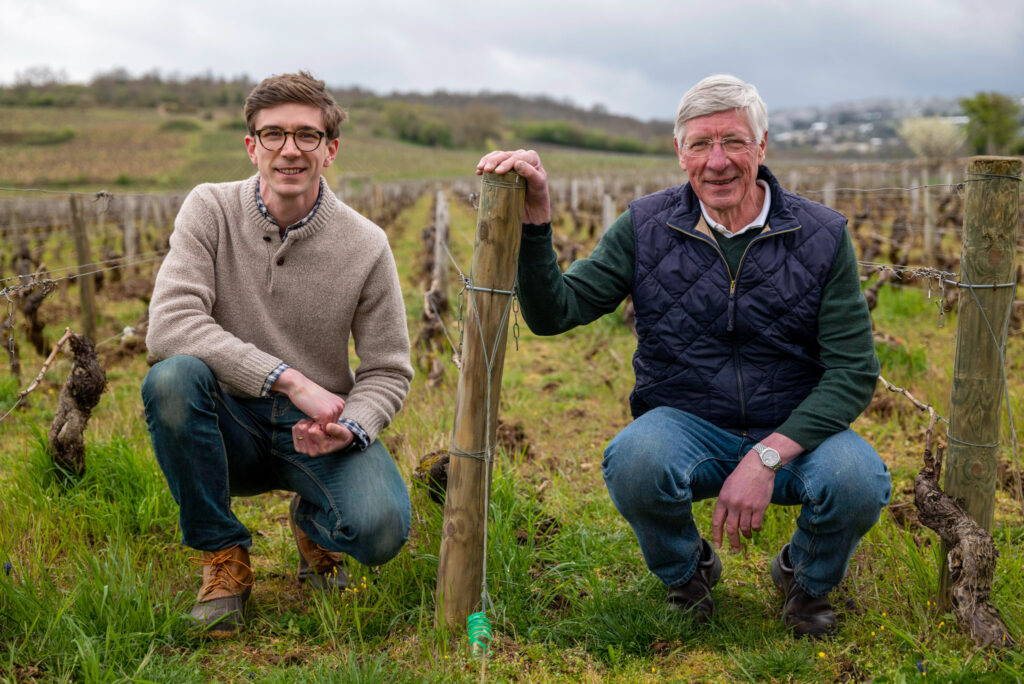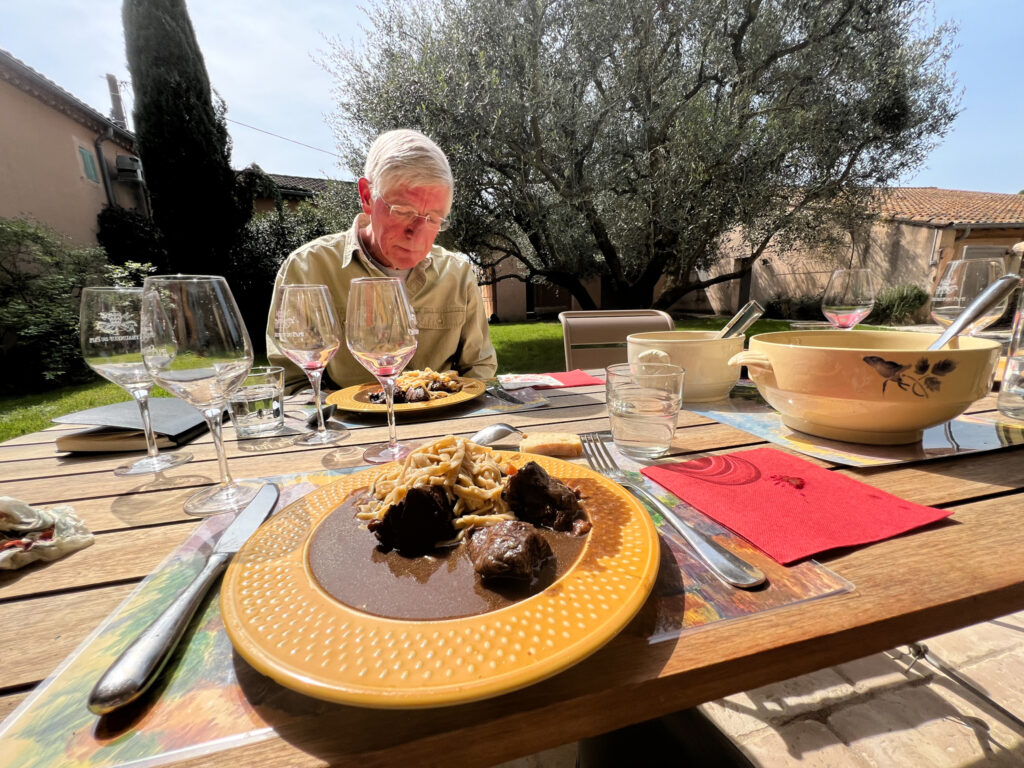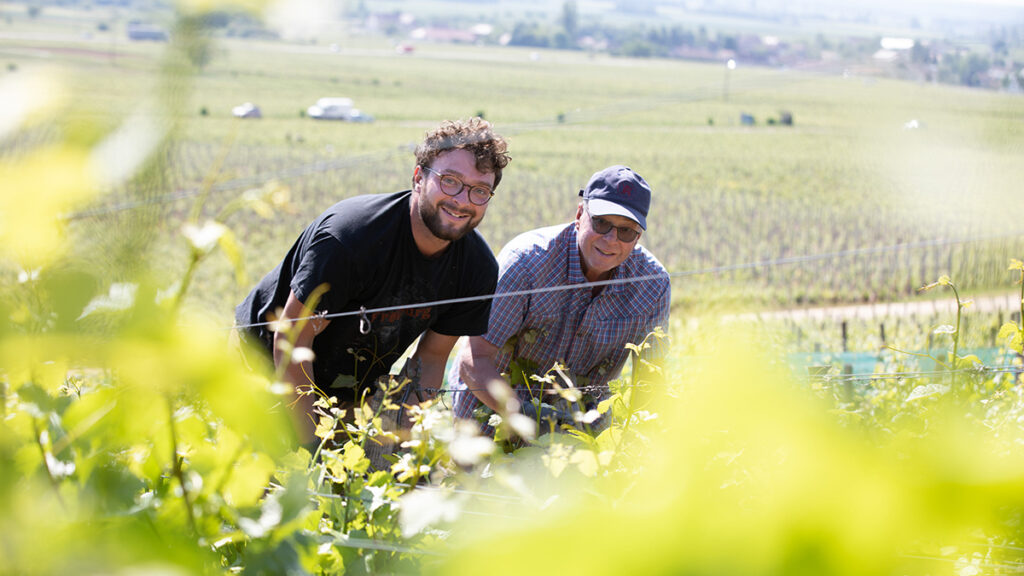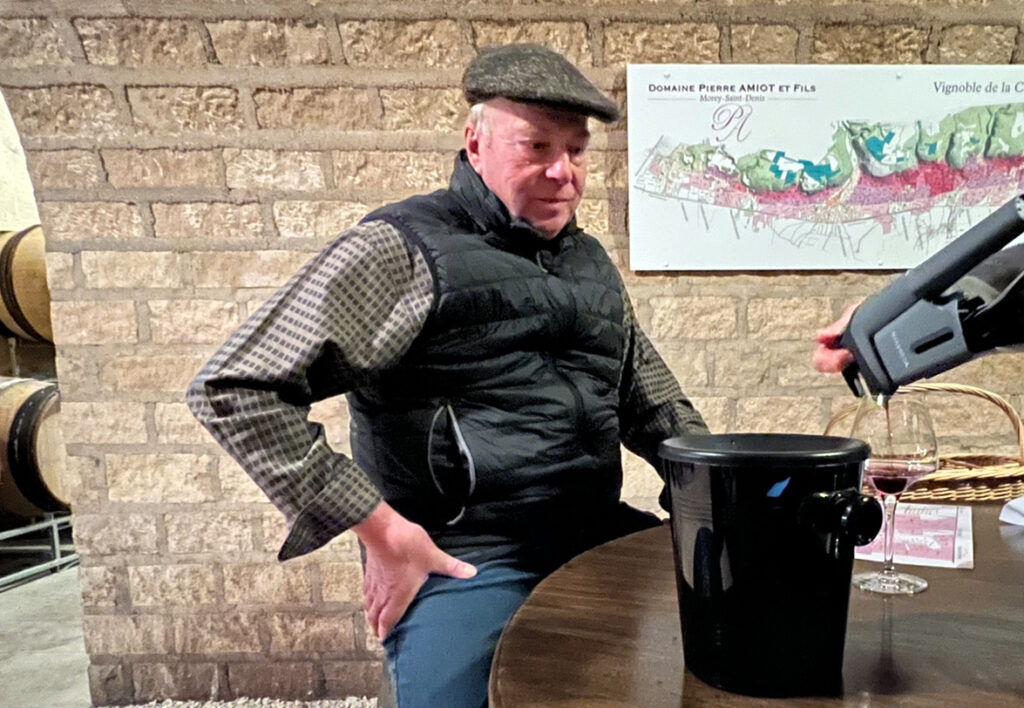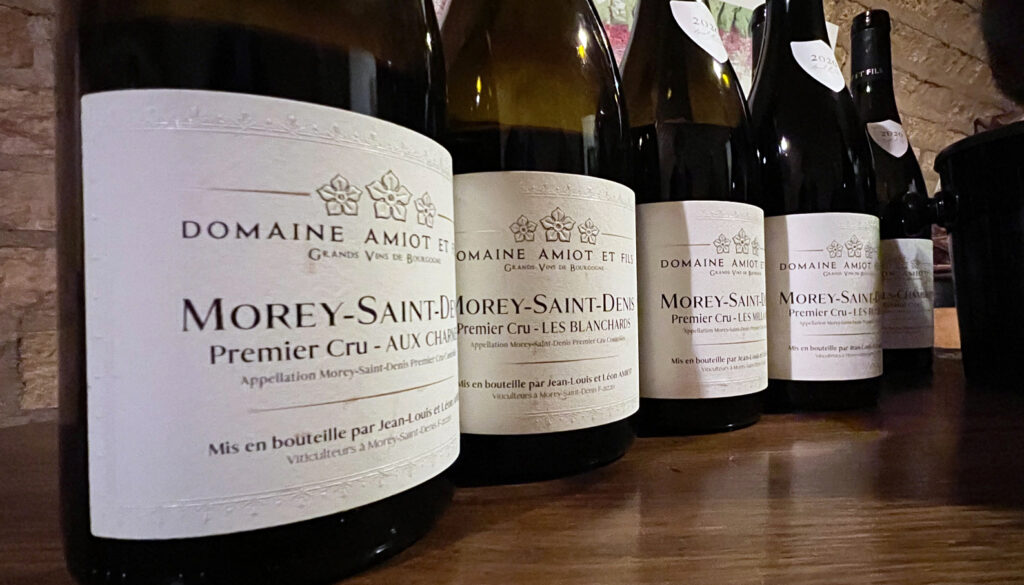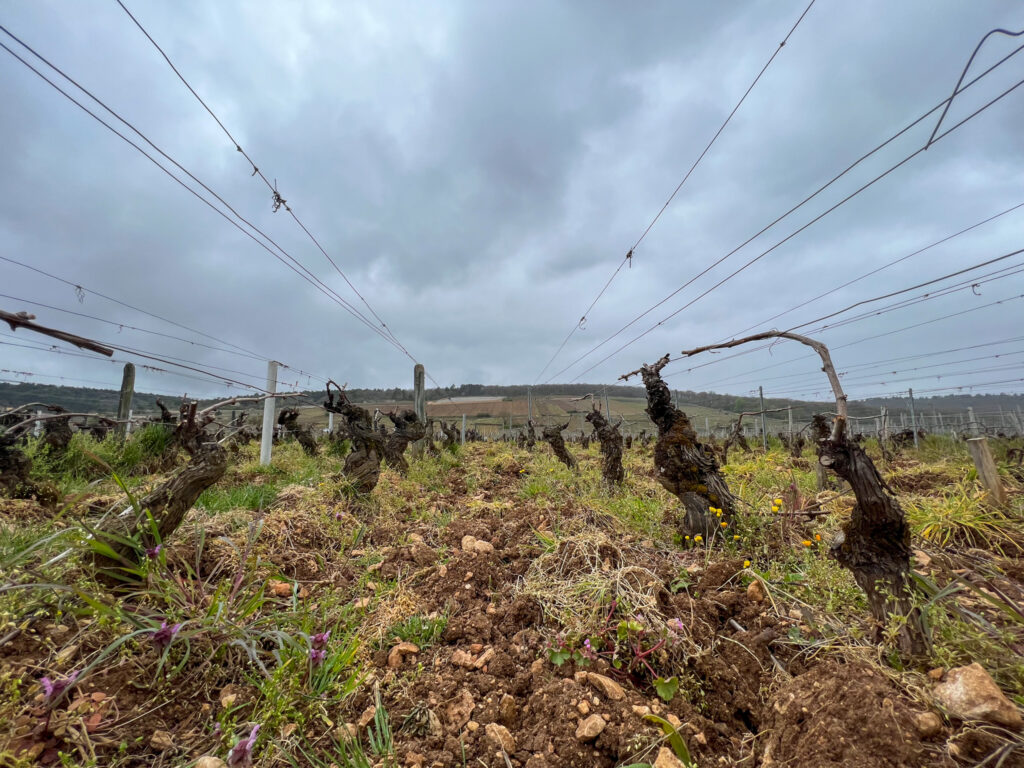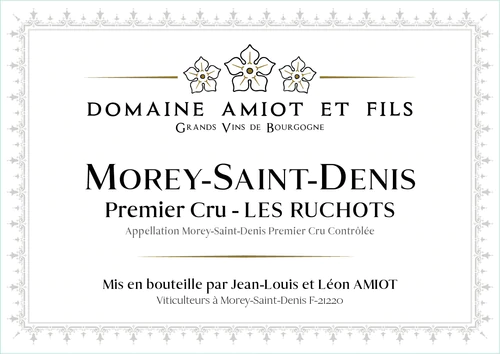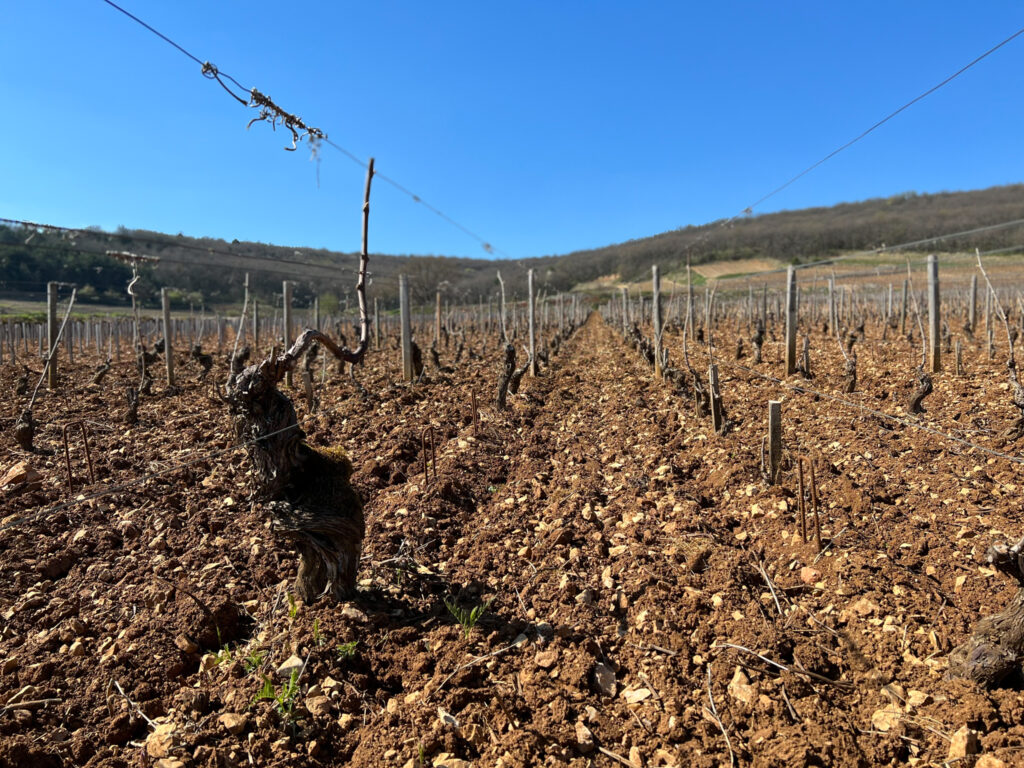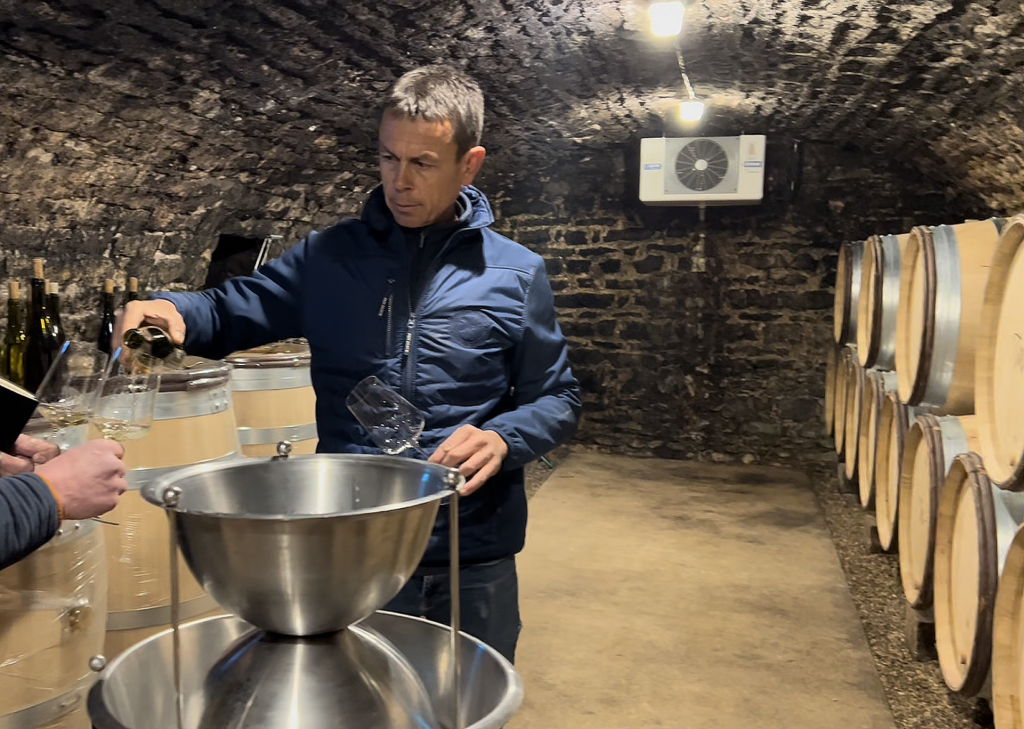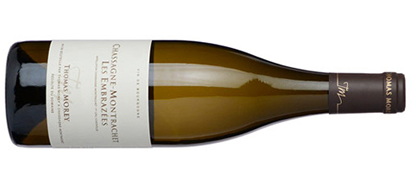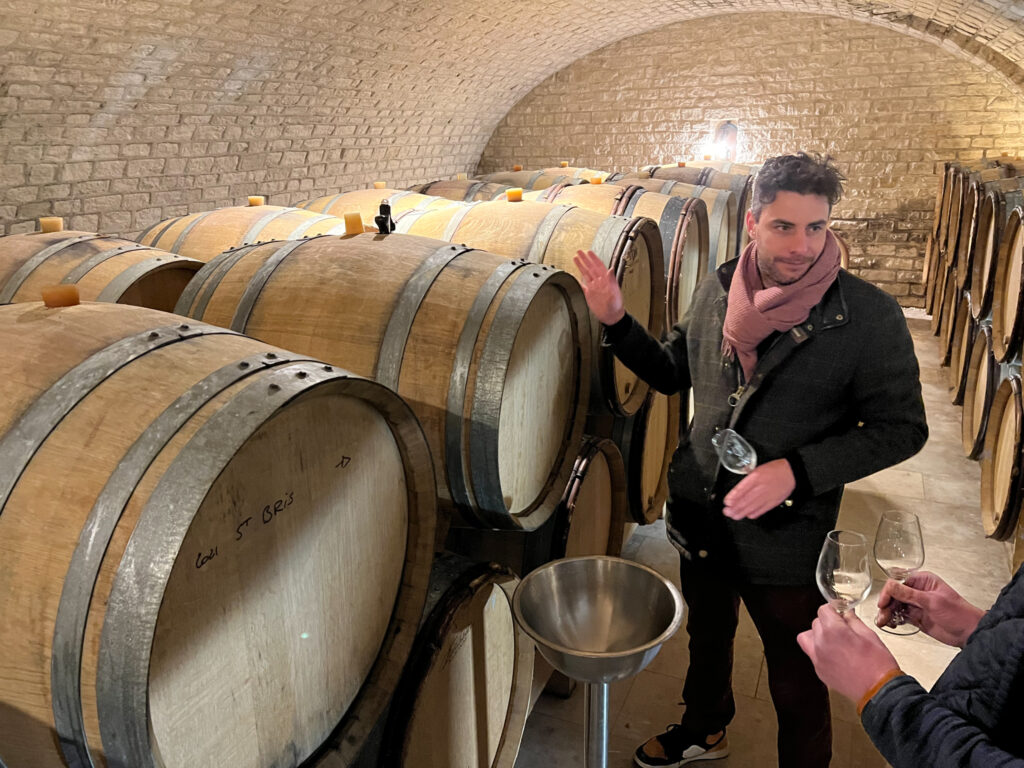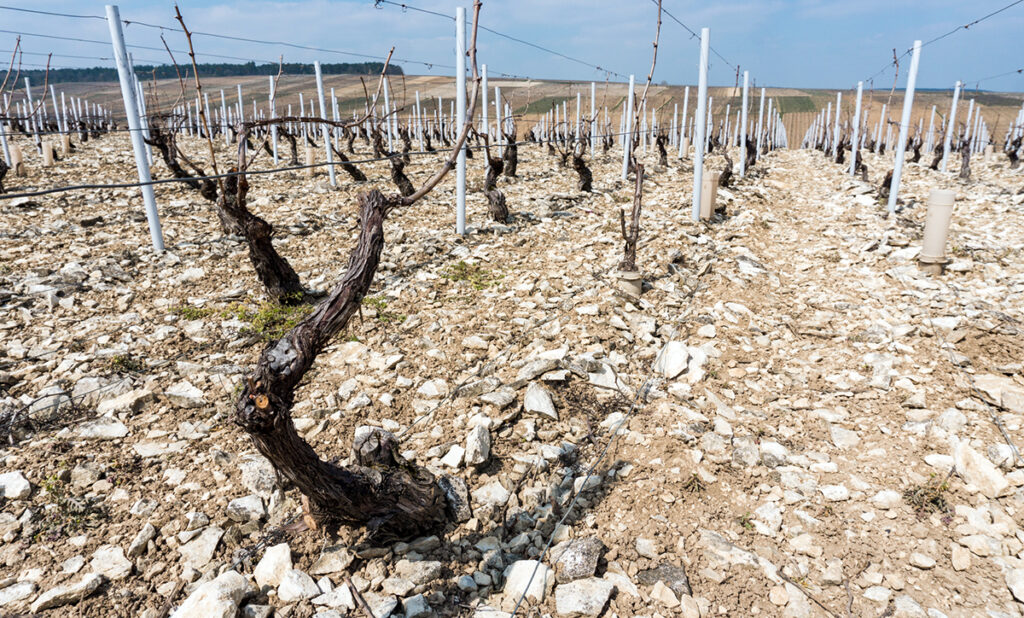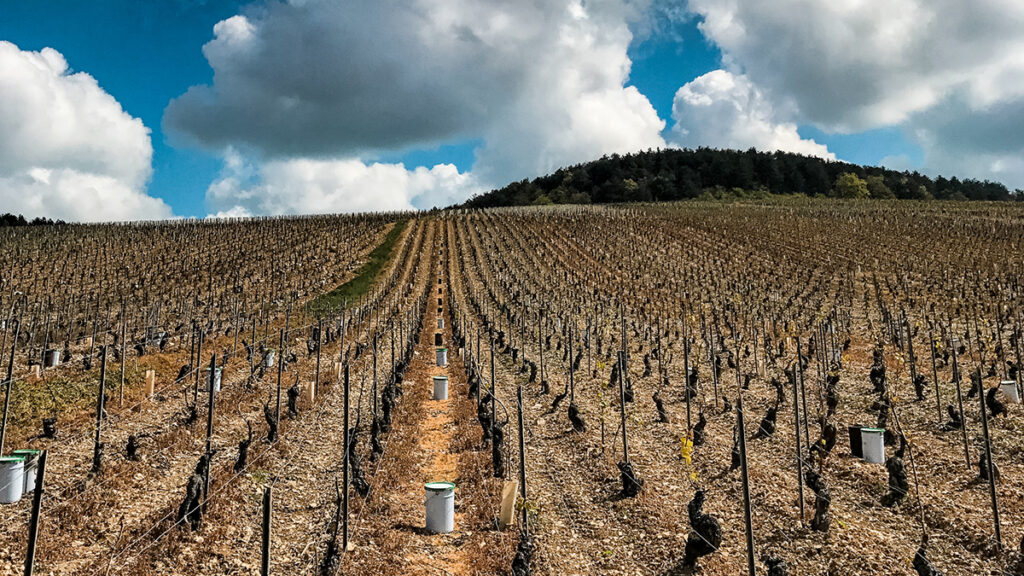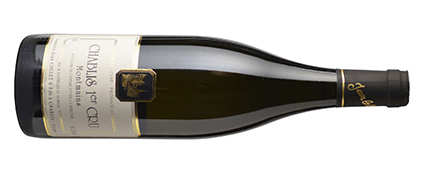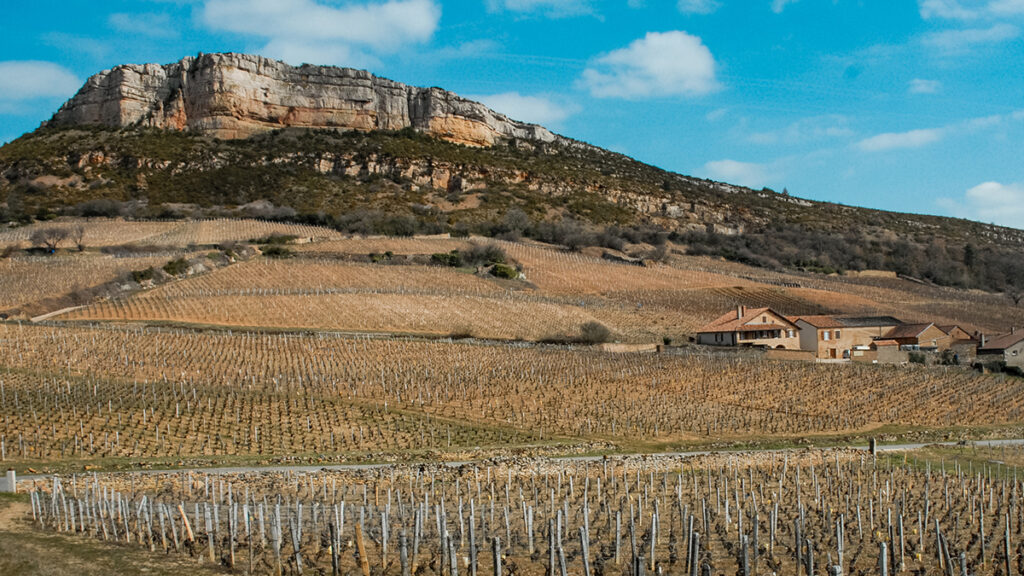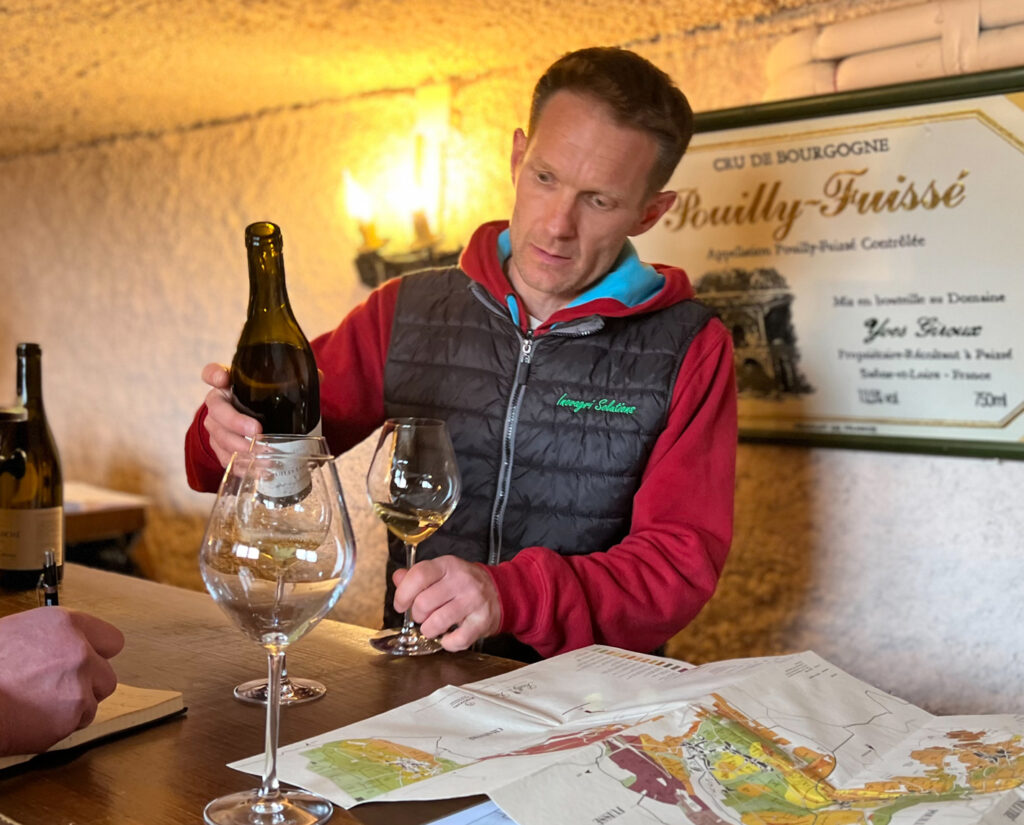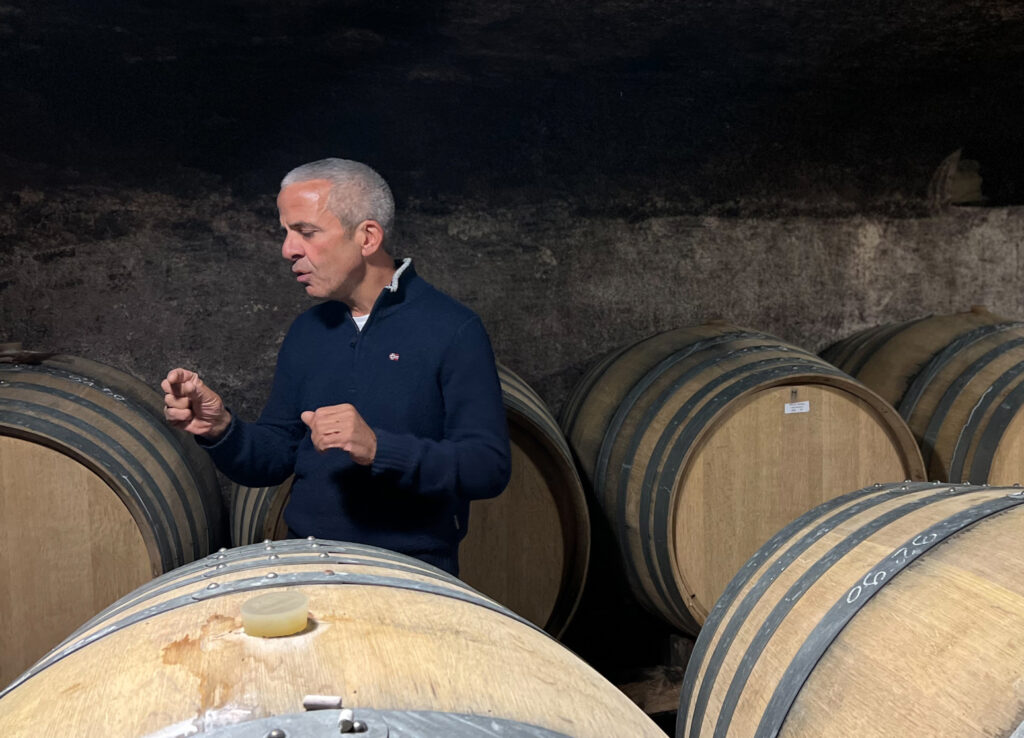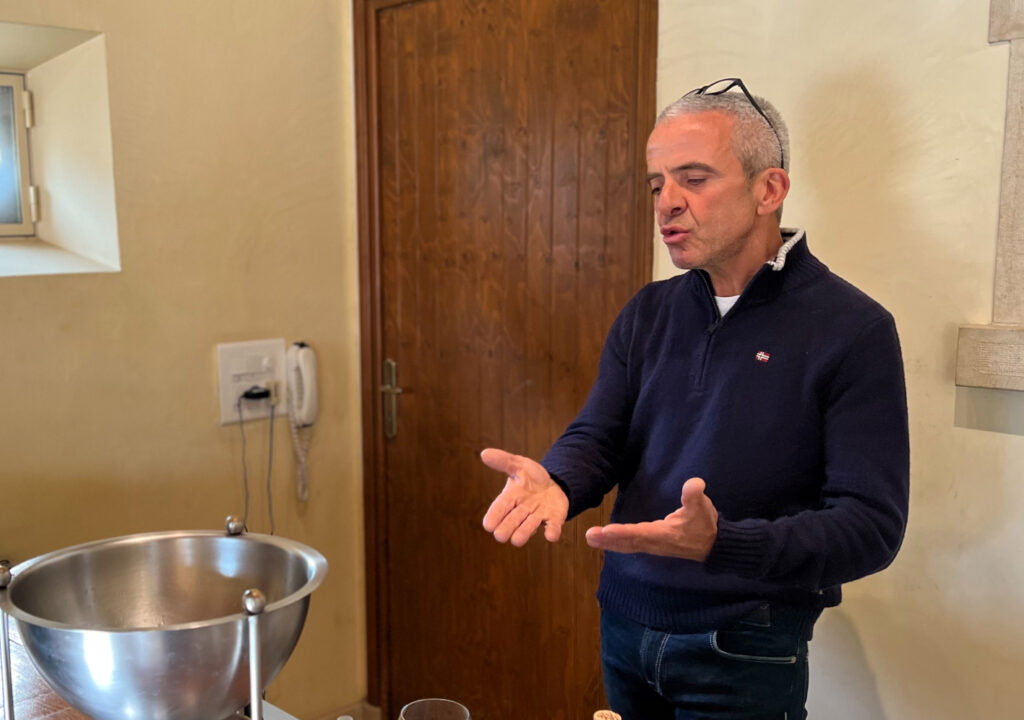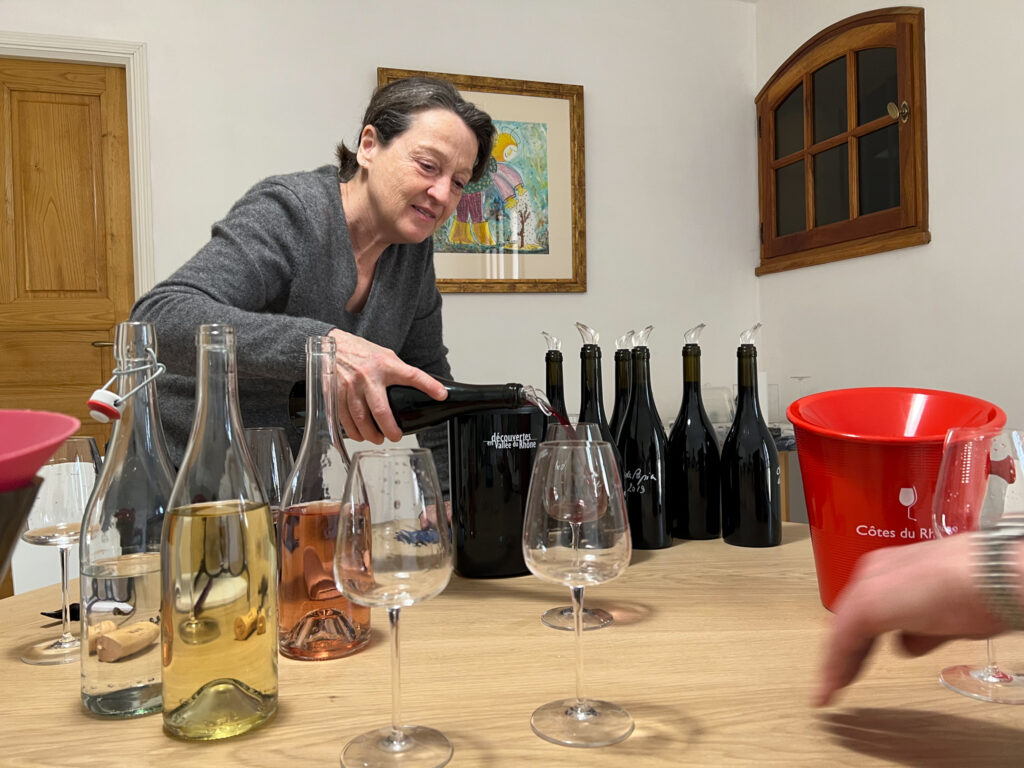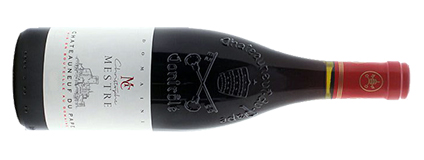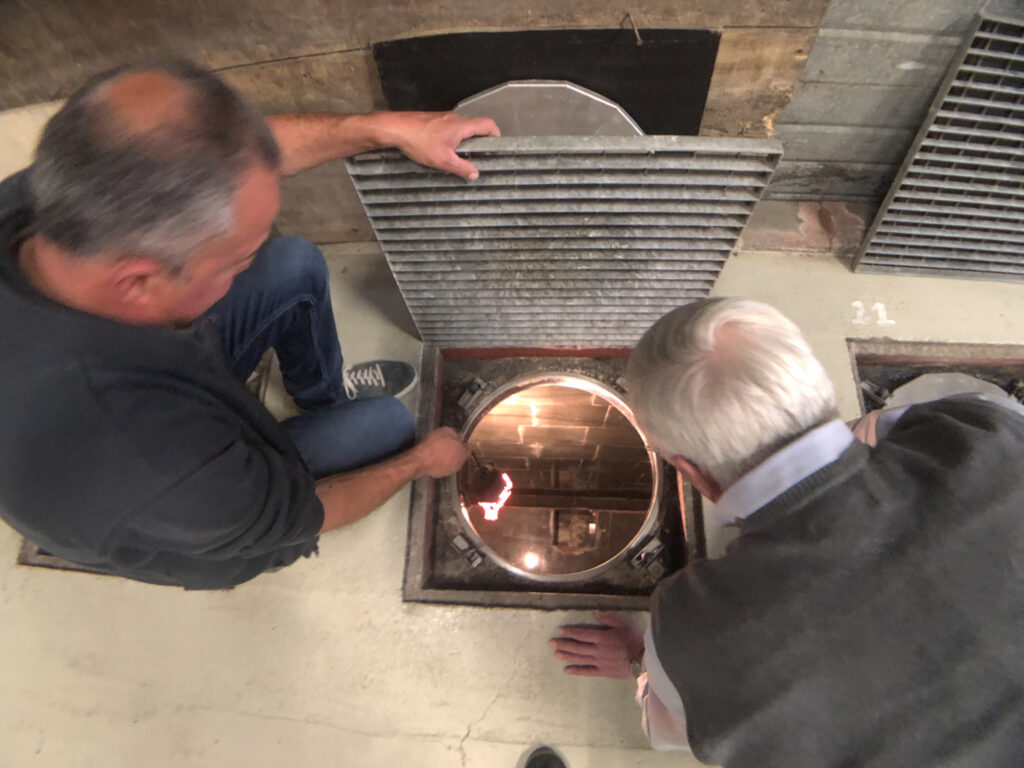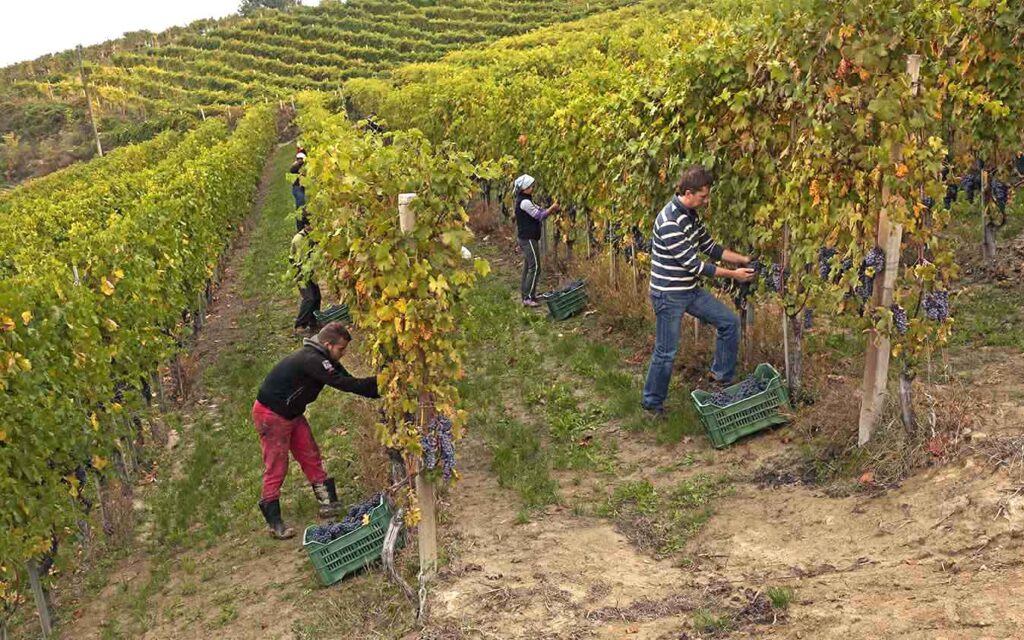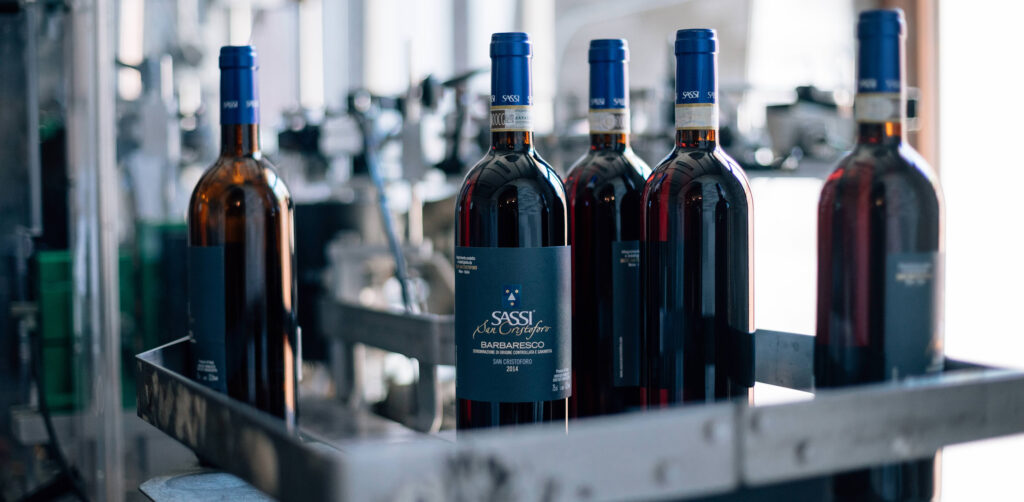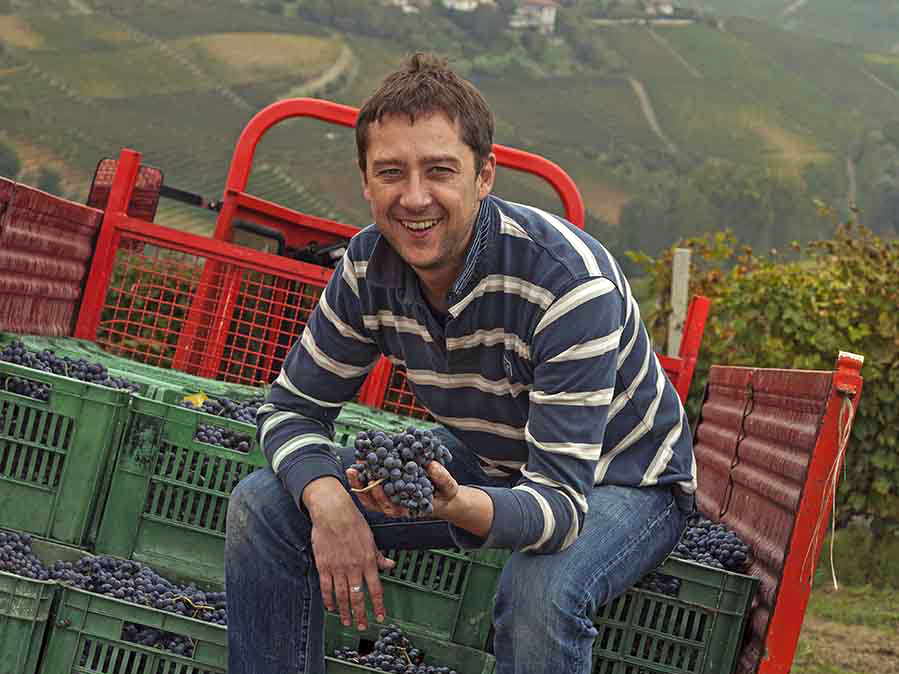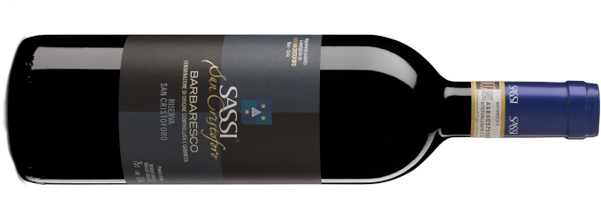After three long years away from France’s vines and vignerons, Ansonia Wines returned at the end of March and early April. It was a genuine pleasure. We learned that our friends in France are just as anxious as everyone here to see Covid in the rearview mirror, and were just as pleased as we were to spend a bit of time together in person. We found that the 2020 vintage, which began going into bottles a few months ago, completes a trio of years that are both ageworthy and easy to drink young. And generally we delighted in driving through the towns that have become familiar over the years, seeing places we know well and trying new ones that might be worth knowing. Though much was familiar, there were new things to notice as well — particularly as a new generation of vignerons more fully embraces organic and biodynamic practices and otherwise brings innovation to the vineyards and cellars. These days a visit to the vines often reveals plenty of grass (and many different grasses) between the rows, as well as plots with higher or different trellises for training the shoots, as both vines and vignerons adapt to new weather patterns. Similarly, a trip to the cellars finds not just stainless and concrete vats, foudres and small barrels, but enormous cement eggs and amphoras. This futures offering has a mix of new and old producers, from familiar and well-known favorites such as Amiot and Morey and Collet, to new names and faces, including two producers from southern Burgundy and even one from Barbaresco (!). We cover a lot of French territory here — plenty of Burgundy of course, but also wine from the Loire, the Rhône, and Bordeaux. As always, we have tried to include wine for all tastes and budgets. We hope you’ll find something of interest. If you do, please complete and submit the order form by the ORDER DEADLINE of MAY 15, 2022. We will place the orders for your wine immediately thereafter. JUMP TO SECTION
Amiot
Morey
Collet
Giroux/Vessigaud
Joncuas
Mestre
Martin-Luneau
Fleuron de Liot
Sassi San Cristoforo
May Futures
Order Deadline: 5/15
Domaine Amiot et Fils
Morey-St-Denis, Burgundy
With the 2020 vintage, the Domaine Pierre Amiot has become the Domaine Amiot et Fils. Jean-Louis’s brother Didier has gone off on his own, and son Léon has joined Jean-Louis and Chantal in the business. We expect no change in the winemaking, as Jean-Louis has been the principal winemaker for many years with Léon working at his side. The 2020 vintage was the third year in a row of unusually hot weather, resulting in a harvest that began in August for the first time in Jean-Louis’s long career. The heat came with an extended dry spell, which contributed to concentration and low yields. The pleasant surprise was that despite the very ripe vintage, both red and whites retained excellent freshness, as the acidity seems to have been concentrated along with the sugars. In fact, the only thing wrong with the 2020s is that there’s not much of them. At Amiot as elsewhere, the wines should be easy to drink young but also ageworthy. At the regional level, there’s a new wine to offer. The Coteaux Bourgignons 2020 is a blend of equal Pinot Noir and Gamay, raised for a year in older barrels. The result is a pleasant, straightforward glass with good freshness and lighter body. It will be a great choice to serve cool with barbequed ribs on a warm August day, or with the tailgate picnic at a fall football game. Amiot’s Bourgogne rouge is always one of the best regional Burgundies in our lineup, and the 2020 is as good as ever. It’s 100% pinot noir, with darker fruit and more depth than its half-gamay cousin. Look for notes of plums and minerals, with low oak and a clean finish. (Note that quantity for both of these is extremely limited, and at the prices we expect to run through our allocation quickly.) For a few years now, the Domaine has made a village-level Gevrey-Chambertin, partially from purchased grapes. The wine seems to get better every year, and we found the 2020 particularly attractive, with a fine nose of dark fruit, plenty of depth and intensity, and silky-smooth tannins. Look for violets, cassis, and a delicious briary finish – proof of just how good the winemaking is here these days. In the 2020 vintage there’s also tiny amount of a village-level Chambolle-Musigny from purchased grapes. This is also very nice, showing a bit more structure than the Gevrey (15% whole cluster), and probably peaking a bit later. For those with some patience and cellar space this will handily overperform its classification level in due course. The 2020 Morey St. Denis premier crus are all delicious. As usual, the Morey St. Denis 1er cru “Charmes” 2020 will be the earliest to drink well. Somewhat unusually for a premier cru of this level, the Amiots age this only in older oak barrels (none new) – but the decision is well founded. They use 20% whole cluster fermentation to provide some definition and structure behind the loads of dark ripe fruit. Allen Meadows found “cassis, black cherry and spice” suffused by “hints of wood toast and menthol” in its ripe nose. Charmes is good every year, but in 2020 it’s a triumph. The Morey St. Denis 1er cru “Les Millandes” is aromatically similar to Charmes, but bigger wine with more structure and a drinking window that opens just a little later than Charmes (30% new oak, 30% whole clusters). The structure is serious and polished, with fine tannins that carry through the long, clean finish. As Burghound compared them, there is “more size, weight and obvious power to the bigger-bodied flavors.” The last premier cru is from Morey-St-Denis 1er cru Ruchots, a perfectly located vineyard considered the finest premier cru in the town. This vineyard sits between the Grand Cru Clos de Tart and the Roumiers’ monopole “Clos de la Bussiere,” and the wine it produces is what you’d expect – intense, masculine, bold, and beautiful. As usual, it is a notch up in refinement and density from these other excellent premier crus. Some of the vines here date to the 1930s, and we thought the 2020 showed a striking combination of finesse and power. Burghound gave 90-93 points, calling it “outstanding,” “sappy” and “velvet-textured” with “excellent volume.” You can’t go wrong with any of these choices. The Domaine’s Gevrey-Chambertin 1er cru “Les Combottes” (see photo of soil above) is a near-Grand Cru in more ways than one. First, it is surrounded by Grand Cru vineyards: Clos de la Roche to the south and west, Latricieres-Chambertin and Charmes-Chambertin to the north and east. More importantly, it offers concentration and intensity that elevates it into the Grand Cru neighborhood. Burghound praised its “floral-suffused aromas of various dark berries, earth, and hints of the sauvage.” At a price materially below Grand Cru pricing, you can have a wine that on a good day will rival them. If you’re interested in real Grand Cru, the Domaine Amiot has very small quantities of two on offer. First, there is Clos de la Roche Grand Cru 2020, a truly impressive wine that will require time to come into its own. Burghound praised its “excellent richness,” finding “markedly spicy aromas of black cherry, poached plum, and smoked meat.” It will be best to put it at the back of the cellar for a few years, but patience will certainly be rewarded. There are also a very few bottles of Charmes-Chambertin Grand Cru 2020, made from purchased grapes. We thought this much like the Clos de la Roche: a dark and dense wine that will need time in the cellar to smooth out and come together.
AMIOT Coteaux Bourguignons 2020: $195 Gevrey-Chambertin 2020: $695 Clos de la Roche Grand Cru 2020: $2,395
(case prices)
Bourgogne Rouge 2020: $295
Chambolle-Musigny 2020: $895
Morey-St-Denis 1er “Charmes” 2020: $895
Morey-St-Denis 1er “Millandes” 2020: $895
Morey-St-Denis 1er “Ruchots” 2020: $995
Gevrey-Chambertin 1er “Combottes” 2020: $1,095
Charmes-Chambertin Grand Cru 2020: $,2395
Thomas Morey
Chassagne-Montrachet, Burgundy
Thomas Morey continues to turn our extraordinary wine, and his 2020s are strikingly good across the board. We’re not the only ones to notice. Jasper Morris MW, author of Inside Burgundy (whose massive Second Edition of his book on Burgundy has garnered praise throughout the wine world), just issued notes filled with praise for Morey’s wine in both colors, “as we have come to expect from this exemplary vigneron.” As we have reported before, to the surprise of many wine writers, 2020 produced whites that are lively and fresh as well as opulent. Serious lovers of white Burgundy will do well to put some of this vintage in the cellar, and you cannot choose better than the pure, precise style of Thomas Morey. What is more, we are delighted to have a few additional wines from the Domaine to offer you this year. The St. Aubin 1er cru “Les Castets” 2020 is on offer again, and it is just as beautiful as it was last year. Like the rest of Morey’s wines in this vintage, the balance is just right: round fruit in the mouth, but supported by a lively freshness. As Jasper Morris put wrote, there is “fresh white fruit, chiseled limestone clarity behind, with excellent length.” Morey’s Chassagne-Montrachet 2020 garnered a “Five Star” rating from Jasper Morris, awarding 91-93 points and calling it “a superb example of a Chassagne-Montrachet from white wine terroir.” As usual it is a blend from seven different plots of village Chassagne; more mouth-filling than the St. Aubin, but showing the same terrific balance. Morey elects to blend from plots across the appellation, creating an expression of Chassagne as a whole, and allowing him to craft a perfectly balanced wine from a wide array of terroirs. In the bottle for just over a month, it was very expressive when we tasted it at the Domaine, showing notes of sweet cream butter, lemon pulp and the faintest whisper of wood. This wine should drink well young, but will also give pleasure for another five or six years. The Chassagne-Montrachet 1er cru “Embrazees” 2020 (vineyard pictured above) is an elegant wine, rounder and bigger than the village, with a bit more oak in the mix and orchard fruit joining the citrus. The Moreys own most of this vineyard, which lay fallow for decades after the Phylloxera epidemic of the late nineteenth century. Thomas’s grandfather reclaimed the vineyard from forest in the 1960s. Embrazées 2020 is delicious now, but should develop well in the coming years. Morris gave 91-94, calling it “fleshy” with “very good length.” Thomas opened a magnum of 1985 Embrazées when we visited three years ago, and it was still alive and filled with beautiful fruit. The Morgeot sector of Chassagne is a large collection of lieux dits on the west side of the village. There is a lot of variation in elevation and soils, and it’s the fashion these days to bottle the parcels separately; but Thomas Morey has continued his father Bernard’s practice of combining them in a single cuvée. The result is terrific, and we are delighted to have a small allocation of his Chassagne-Montrachet 1er cru “Morgeot” 2020 for the first time in many years. This wine is notable for its concentration and complexity, and showcases the village’s best feature, which is weight without heaviness. The vines here were mostly planted in the 1960s and 1970s, and are prone to millerandage (small berries with a high skin-to-juice ratio), which certainly accounts for its character and completeness. Morris gave 92-94, finding “delicious white fruit” and “excellent length.” We found this wine magnificent this year, with notes of lemon curd, pear and minerals. Most of Morey’s wines are from Chassagne, of course, but there is a single Puligny premier cru from the high slopes of the village. Its terroir is particularly suited to Thomas Morey’s precise style, and his Puligny-Montrachet 1er cru “La Truffiere” is often the most elegant wine from the domaine in any vintage. This being a Puligny, the wine will need an extra year or two to come into its own, but when it does the result will be something special. Floral notes of white peach flower come into the mix of fruit and minerals, and the wine lingers on the palate. Morris praised its “pure and thrilling intensity of fruit.” The top of the list here is always the Bâtard-Montrachet Grand Cru, and as usual we have only a very few bottles to offer. The Montrachet complex of Grand Crus — with Montrachet straddling the Puligny-Chassagne border, Chevalier-Montrachet above it, Criots-Bâtard-Montrachet to the south, and Batârd-Montrachet below it — is a unique terroir whose white Burgundies achieve an unmatched level of concentration, intensity and age-worthiness. They always require patience, but with good storage it will be rewarded handsomely. Like all the rest from this special terroir, Thomas Morey’s Bâtard 2020 will require a few years, but his deft touch yields a Batârd with unusual finesse. It’s hard to improve on Jasper Morris’s take on the wine, awarding 95-98 points and writing: “There is real power to this lying hidden under the surface, but also Thomas Morey’s stylistic gracefulness of approach. The minerals are dancing just below the surface. Classy, long and balanced. Very, very persistent.” If you have the budget for wine in this category, you’ll love having some bottles in your cellar. (Minimum order is 3 bottles rather than 6 for this wine.) The domaine also makes excellent red wine. Our first suggestion is the premier cru Santenay Grand Clos Rousseau 2020. That town lies on a part of the Côte that faces more to the south, and this gives the reds a character that resembles those of the Côte de Nuits. The wines tend to be fleshy and generous, and the 2020 offers good freshness supporting attractive fruit that resembles fresh strawberry jam. The wine always drinks well young, and the 2020 will be even more approachable when it arrives than usual. Look for gorgeous plummy dark fruit with excellent acidity and laser focus. The reds from the Côte de Beaune north of Santenay have a distinctive character: bright structure with fine tannins that normally need a few years to knit together. The Beaune 1er cru “Grèves” 2020 falls in this category. There is ripe dark fruit with a touch of graphite that is backed up by chiseled, fine-grained tannins right now. With a few years under its belt, this wine will be elegant and refined. It will be a terrific accompaniment for a lean strip steak from the grill.
MOREY St-Aubin 1er “Castets” 2020: $595 Chassagne-Montrachet 1er “Embrazées” 2020: $850 Santenay 1er cru “Grand Clos Roussot” rouge 2020: $495
(case prices)
Chassagne-Montrachet 2020: $650
Chassagne-Montrachet 1er “Morgeot” 2020: $850
Puligny-Montrachet 1er “Truffière” 2020: $1,195
Batard-Montrachet Grand Cru 2020: $3,995
Beaune 1er cru “Grèves” 2020: $550
Jean Collet
Chablis, Burgundy
Chablis may be the last bastion of value in white Burgundy. It lies just about an hour north of the Côte d’Or, and though its grape is also Chardonnay, traditionally Chablis was vat-raised into bright, steely wine, quite different from the opulent, barrel-raised white Burgundies of the Côte d’Or. A warming climate and longer growing seasons have created a wider range of options for the Chablisiens, and today one can find fine white Burgundies there with more than a passing resemblance to those of the Côte d’Or. We love both styles of Chablis, and are delighted to have two excellent producers in the town. One of them hews mostly to the vat-raised, brisk style, and the other offers a smorgasbord of styles and élévage. The latter is the Domaine Jean Collet, a long-established family domaine with fine properties across the appellation. Romain Collet took over as principal winemaker not long ago, and he has transformed the winemaking. He is both a very talented winemaker and an innovator — for proof one need only walk through the cellar, where the stainless steel tanks and large foudres are now joined by cement eggs, demi-muids, and most recently, amphorae. Before tasting the 2020s on offer here, he took us through the 2021 vintage that now populates the cellar, drawing samples from barrels, vats, cement eggs and everything in between. The wine press has been greatly impressed with Romain’s work, and so are we. Collet’s Chablis Vieilles Vignes 2020 is from truly old vines — on average about 85 years. The wine is now raised entirely in stainless steel, so all of its considerable complexity comes from the old vines. It will be a delicious choice for all kinds of pairings from the moment it arrives in the US. The warm growing season in 2020 produced an attractive, fleshy ripeness that will make this wine drink well immediately, either as an aperitif or matched with a wide range of dishes. Its orchard fruit mingles well with the citrus notes, and it has a pleasant round finish. Montmains 1er cru 2020 has the same élevage as the Vieilles Vignes, but comes from different soils. The vineyard lies on the same Kimmeridgian limestone as does the Côte d’Or — soils filled with ancient sea fossils (and less clay than those of Collet’s Vieilles Vignes). The soils join with the vineyard’s south-east exposition to add precision and length. This Montmains is surprisingly rich, but also has supporting freshness that will carry it for perhaps three to five years. Forêts 1er cru is particularly elegant in the 2020 vintage. This lieu dit is actually at the top part of Montmains, and the farming has been certified organic there since 2018. Its élevage is more complicated, with 90% raised in cement eggs (whose shape fosters natural circulation of the lees over the lunar cycles). The last 10% is raised in Burgundy-sized barrels, bringing a soupçon of oak into the mix. The result is extra refinement and complexity, the sort of hard-to-explain quality that will cause a taster to add an asterisk to the margin of his tasting note. Many of you have already read about the Montée de Tonnerre 2020 in last weekend’s post. This top premier cru vineyard produced very attractive wine in 2020, offering a combination of power, length, and complexity that is hard to beat. The nose is deep, dry, and beautifully layered, with white flowers, saline, seashells and lemon peel. The mouth is rich but not heavy, with oak carefully integrated and notes of dry apple and stones. Jasper Morris gave 90-93, calling it “harmonious” and “one of the more powerful wines” in the lineup. Burghound awarded 90-92, finding “excellent volume” and calling it “unusually powerful yet refined.” Though you will pay more for Collet’s Grand Crus than for any other wines in the lineup, they may be the best value there. For the price of a village level red from the Côte de Nuits, you can put a Grand Cru white Burgundy in your cellar. The Collet family has long owned an excellent parcel in Valmur, a Grand Cru vineyard at the center of the group that contains all of Chablis’s Grand Crus. For the last five years or so the Collets have also farmed a parcel in Les Clos, the most famous of all the Chablis Grand Crus. Both of these wines are strikingly good — beautifully rich and round, with extraordinary intensity and length. They need a bit of time to show their quality, but a little keeping will be well rewarded. Like the white Grand Crus of the Côte d’Or, these wines are raised in small oak barrels (for 13 months), adding complexity and evolution; and then allowed to knit together for five months en cuve. Both wines were bottled in March. The Valmur Grand Cru 2020 is big and concentrated. Burghound commented on its “impressive density” and the “exceptionally rich large-bodied flavors.” He thought it might drink well earlier than usual. Les Clos Grand Cru 2020 typically shows great finesse, and in 2020 the wine shows a racy vibrancy along with its richness. Burghound praised its “aromas of white flowers, sliced lemon, and a whiff of the exotic.” He thought Valmur might eventually score a 92, Les Clos a 93. We’re confident that you will be glad to own either (or both).
Giroux / Vessigaud
Pouilly-Fuissé, Burgundy
During the sabbatical year that eventually led to Ansonia Wines Père et Fils, Pouilly-Fuissé and its environs were a favorite haunt for the Wilcox family. There was a restaurant in Fuissé that provided the perfect venue for the French national sport — Sunday brunch. The nearby views included not only the dramatic jutting cliffs of Solutré and Vergisson, but vineyards that lined all the slopes below them. For many years, until his retirement half a dozen years ago, the followers of Ansonia Wines enjoyed superb white Burgundy from a favorite vigneron in Vergisson, Michel Forest. We’ve been meaning to return ever since. Pouilly-Fuissé is getting well-deserved respect in the wine world these days, and beginning with the 2020 vintage some vineyards are entitled to the “premier cru” designation. This year we decided it was time to bring some wine from the appellation back onto our list, and so we picked two promising addresses to visit in April. The idea worked too well — we liked the wines of both producers so much that we couldn’t pick one over the other; and so we’re presenting them both to you. All five wines are pure chardonnay, ranging from unoaked to limited oak. Indeed, a globally growing distaste for excess wood and a reluctance to add more softness to already ripe wines makes it rare to find overoaking in Pouilly-Fuissé these days. If the appellation brings to your mind a glass of buttered popcorn at Lutece during the seventies, Pouilly-Fuissé has probably changed as much as you have since then.
SEBASTIEN GIROUX Giroux’s Macon-Fuissé “Vers Chanes” 2020 is a remarkably good value. The vines lie just outside the Pouilly-Fuissé appellation, on higher ground with a bit more clay. Perhaps the wine benefited from its altitude in this very hot and dry vintage, but whatever the reason, it shows beautiful balance, offering a blend of orchard and citrus fruits that mingle with a lovely mineral line. There’s a touch of salinity on the finish that gives the wine a dynamic feel. At less than $20 for Futures pricing, it’s hard to resist this one. We have two Giroux Pouilly-Fuissés from the 2019 vintage. Pouilly-Fuissé “Raidillons” 2019 comes from limestone soils situated over marl (causing the vines to suffer a bit, according to Sebastien). The wine spent about six months in barrels, followed by six months en cuve. Kelley praised this wine as “rich and layered,” “[u]nwinding in the glass with notes of pear, white flowers,… and mint,” and gave 90-92 points. There is a terrific mix of fruit and minerals here, offered in a racy style. The texture is thick and concentrated but with excellent focus. Sebastien’s old vine Pouilly-Fuissé comes from vines planted in rocky soil in 1942. The Pouilly-Fuissé Vieilles Vignes 2019 spent a year in oak barrels, followed by almost a year en cuve. The nose features pure fruit accompanied by a lovely minerality, and the wine has a distinct lift, a “côté aerienne” as the French put it. (For Ansonia Wines old-timers: it reminds us of the old vine cuvée from Michel Forest). Kelley ranked it a point above the Radillons, calling it “fleshy but precise, with vibrant acids,” and “one of the highlights of the range this year.” The oak is perfectly integrated into this wine, with tightly channeled energy and seemingly unending finish. This doesn’t taste like Meursault – indeed it could only be from the Maconnais – but the layered complexity and subtle depth could easily rival some of the great whites of the Côte d’Or.
Sebastien Giroux has 6 hectares of vines in and around Fuissé. The wines are very much handmade, with elevage carefully calibrated according to vineyard and vintage. Sebastien bottles only when he feels his wines are ready. A case in point: there is still a tank of unbottled 2019 in his cellar. We were drawn to the domaine by praise from William Kelley MW, who described the wines as “supple, pure, and charming.” He was entirely correct.
GIROUX Macon-Fuissé 2020: $235
(case prices)
Pouilly-Fuissé “Radillons” 2020: $325
Pouilly-Fuissé Vieilles Vignes 2020: $325
PIERRE VESSIGAUD It was once again a note from William Kelley that sent us here, and we found his impressions spot on yet again. He calls Vessiguad “a source of fine wines that deserve to be better known… Yields are limited to 40 hectoliters per hectare, a rarity for the region and which likely accounts for the concentration of these wines…. Succulent but serious, any bottle bearing Vessigaud’s label is well worth seeking out.” The Vessigaud Pouilly-Fuissé 1er cru “Les Vignes Blanches” 2020 is from the lieu dit “Vers Agnieres,” an east-facing plot on Chouin Limestone in the village of Fuissé. The soils give it a clear mineral line, which marries well with the richness of the ripe vintage. We found terrific depth in this wine, easily worthy of the vineyard’s new premier cru status. The nose is subtle and deep with careful integrated oak and an expansive array of pear, apple, and quince fruit. The palate is rich and mouthfilling but with an electric current of freshness. Given the acidity in this wine we think it should cellar well for another year or two, though the ripeness means it’s awfully hard to resist today. The Vessigaud Pouilly-Fuissé 1er cru “Les Reisses” 2020 is from a marl and limestone plot called “Vers Pouilly,” also in the village of Fuissé. The vines here are between 60 and 80 years old — about twice as old as those in “Vers Agnieres.” The old vines make a lot of small berries (millerandage), which produces concentrated wine of greater power and length. The lingering finish of this wine is particularly noteworthy. The nose here is more serious and perhaps drier – more tightly focused and less exuberant. The mouth is tremendous, with a depth and length to rival a Puligny-Montrachet. This is more regal in nature than the exuberant Vignes Blanches, but it’s hard to imagine either disappointing anyone.
Pierre Vessigaud farms 11 hectares in the same neighborhood as Sebastien Giroux. Vessigaud has a precise, scientific approach to his craft, and a firm grasp on the winemaking variables at his disposal. He’s been farming his vines organically since 1988, and is the fifth generation Vessigaud on his land – his three decades of experience (and centuries of collective wisdom) show in his wines’ superb focus and polish. His wines undergo a leisurely élévage, first 12 months in older large barrels (600 liters), then 6 months en cuve.
Clos du Joncuas
Gigondas, Rhône Valley
The vineyards of Gigondas lie near the Dentelles de Montmirail, the “lace” mountains on the eastern side of the alluvial plain that holds the vineyards of Chateauneuf du Pape. Their elevation is higher than Chateauneuf — this provides the lift and cut that distinguishes Gigondas from its famous neighbor — but in fact elevation varies widely within Gigondas. This visit provided our first opportunity to visit the vines of the Clos du Joncuas, and we were surprised at just how high its terraced vineyards are, well into the foothills of the Dentelles. You need both good tires and some heart to drive up the switchbacks to its terraces, but when you do you are rewarded with a look at the bulrushes (Joncuas) from which the Clos takes its name. The Chastan family has been making wine in the same style for two generations. They were among the earliest in the region to farm organically (they were certified in 1980!), and their winemaking is simple and straightforward. Vinification for all the wines is cement vats, followed by an elevage in either vats or neutral oak foudres. The wines are neither fined nor filtered. We have two vintages to suggest for the Gigondas, which is 80% Grenache, 15% Mourvedre, and 5% Cinsault. The Clos du Joncuas Gigondas 2020 is an easy, early-drinking vintage. It is silky smooth and rich, with dense, sweet fruit and notes of allspice. Though velvety, there is good underlying structure and a bit of earthiness in the finish. A dose of salinity balances the lush fruit, making this a delightful young wine we think will drink well for several years. The Clos du Joncuas Gigondas 2019 has more structure and more prominent tannins than the 2020, but it is also very round, and also eminently drinkable already. There’s a bit more minerality mixed in with the ripe fruit here, and the wine may have a longer drinking window; but both wines are generous and fleshy, and will be easy to match these appealing wines with hearty stews, meats from the grill, or Italian cuisine, particularly pastas, to name just a few. The Chastan family also has vineyards in two adjoining appellations: the Domaine de la Garancière in Séguret and the Font de Papier in Vacqueyras. The Séguret “Garanciere” 2019 is a blend of 70% Grenache, 20% Mourvedre, and 10% Carignan. It offers pleasant dark fruit supported by fine-grained tannins. It’s lighter in weight and less refined than the Gigondas cuvées, but it offers both good tension and good length. The Vacquéyras Font de Papier 2019 (named for the “Popes’ Fountains”) is between the Gigondas and the Séguret in weight. The wine is particularly attractive in the 2019 vintage. Its dark fruit comes from a blend of 80% Grenache and 20% Mourvedre, vinified mostly from whole clusters. The wine is rich and round, with dense, fine-grained tannins and excellent balance. We think this wine rivals a Gigondas this year for its intensity, and expect it to be a crowd-pleasing everyday red when it arrives.
Domaine Mestre
Châteauneuf-du-Pape, Rhône Valley
Christophe Mestre and his wife are from old Châteauneuf du Pape families. Like many such families, their vines are in plots scattered across the town’s remarkably diverse terroir. Their parcels cover all three of Châteauneuf’s famous terroirs: the galets roulés, (large round stones, see photo); alluvial sandy soils, and red and brown soils rich in pebbles and limestone. Mestre makes a single red cuvée from these terroirs, seeking an expression of the appellation as a whole. It’s always delicious, and always well priced. Christophe has just been joined by his son Remi, who (along with quite a few other Gen Z winemakers) brings an interest in whole cluster fermentation and single-varietal experimentation. As we have said, we much enjoy watching the generations work together at our producers, as new ideas mix with long experience. We’re thrilled to see this multigenerational domaine enter that phase, and if early indications are any predictor, there will be much to like here in the coming years. Mestre’s 2019 Châteauneuf-du-Pape is not a complicated wine, and probably not one for the back of the cellar. But today, and for the next few years, it should offer pure, unbridled hedonistic delight. It’s a blend of 50% grenache, 25% mourvèdre, 20% syrah, and 5% cinsault. The nose explodes with ripe strawberry fruit and a pleasant cool earthiness. Despite a blistering hot year, Christophe managed to build tannins behind the fruit beautifully, and this wine is well defined and not the least bit flabby. The mouth is rich and ripe, with remarkable intensity and length for its price. This should arrive in time for autumn tailgating, and it will be a crowd-pleasing wine to pour generously and often. With a Futures price under $28 (and magnum price under $55), it’s hard to think of a better value in our Southern Rhône collection.
Martin-Luneau
Muscadet, Loire Valley
Muscadet has come a long way in the last decade. For many years, there were just two categories of this simple wine from the mouth of the Loire: Muscadet and Muscadet de Sèvre et Maine sur lie. The former was what arrived in a pitcher if you ordered a dozen oysters in a waterside cafe in Cançale or Nantes. It was refreshing and light — a great way to wash down the oysters without getting in their way at all. The latter was a bit more serious. Still made from the Melon de Bourgogne grape (which is way more Melon than Bourgogne), the Sevre et Maine area could yield wines of more interest, particularly when raised on their lees for a time. But these designations shortchanged the grape. When raised on certain soils and given an extended elevage on the lees, Melon de Bourgogne can make wine of substantial complexity that can improve with age. For just over a decade now, the appellation recognizes a “Cru” designation for particularly favored terroir. There are also rules requiring extended aging on the lees, and limiting the quantities that may be produced per hectare. Our producer Martin-Luneau has vines in two of the first appellations to be granted “Cru” status: Gorges and Clisson. We have been delighted to get to know these wines, which show a real step up in complexity from the base appellations. The other happy surprise has been to see just how ageworthy these wines are. With seven or more years in the bottle, the wines round out even more, and offer iodine, seashells, salt spray, and other maritime essence on the palate. Usually we bring in both Gorges and Clisson, but in the current vintage we were particularly taken with the Gorges 2018, and so we have made that selection for you. The wine is still the perfect match for oysters on the half shell, but with more length and its greater roundness, we often find ourselves reaching for a bottle to go with oven-roasted cod or a simply grilled piece of tuna. The refreshing salinity is there, of course, but there’s more going on in the glass, and it’s a great choice for simply prepared seafood when you don’t want to risk having the wine shout down the fish. The mouth shows pear and lemon, with a pleasant softness from the lees contact (no oak) behind the classic zippy dryness. Martin-Luneau’s crus are attractively priced, but their “Deux Roches” 2018 cuvée is even more so. “Deux Roches” is a reference to the two types of rock on which the grapes are grown: Gabbro and Granite. The vines are all from Clisson and Gorges, and so the wine would be eligible for “Cru” status by virtue of location; but the family has elected to make a refreshing blend for this cuvée, which is priced like a simpler wine. Pick up a case of this to open in the summer weather, and you’ll be surprised at how fast it disappears.
Fleuron de Liot
Saint-Estèphe, Bordeaux
St. Estephe is among the greatest appellations of Bordeaux’s left bank, with storied names like Cos d’Estournel, Montrose, and Calon-Ségur leading its list. We’re not claiming that Fleuron de Liot, a St. Estephe produced in very small quantity, will shoulder these names out any time soon, but neither will you have to consult with your banker to buy a bottle. The wines of St. Estephe tend to be solid wines with strong backbones, or as Hugh Johnson put it, “sturdy clarets which can become venerable without losing vigor.” Fleuron de Liot shares these characteristics: it is a wine of solid structure, dense and precise, that will be a fine foil for a couple of grilled lamb chops. It is assertive enough to hold its own against robustly flavored meat or game, but also offering pleasant dark fruit tinged with a bit of graphite. It is particularly nice to drink after a few years in the cellar. We just sampled the 2014 (the first vintage we imported) and found it open and attractive, with maybe even a touch of Hugh Johnson’s venerability. During our visit to France, we tasted the 2017, 2018 and 2019 side by side. We were impressed with 2018, which had particularly attractive dark fruit and very good balance. Consider putting a case of this in your cellar and opening a bottle every six months or so. You are sure to find a place for it in your pairings and will find plenty of occasions when it seems like just the right bottle. Red Bordeaux can be expensive, ageworthy, and significant – but it’s nice to remember it doesn’t have to be.
Sassi San Cristoforo
Barbaresco, Piedmont, Italy
We rarely have tasting appointments on Sundays in France. We usually use the day to take a break, stretch our legs, and taste through samples sent from domaines we weren’t able to visit. During last month’s trip, our Sunday came after a particularly intense week, with visits at 21 domaines in 5 days and over 300 miles in the car. We slept in a bit, and then dragged ourselves to the kitchen table of our AirBnB to begin to knock out some samples. We’ll admit that most of our job is more fun than work, but the prospect of tasting samples at 9:30 on our only day “off” after an ambitious week was hard to see as anything but work. Context plays a big role in how wine is enjoyed, and so we were surprised and delighted to find our first series of wines were not only excellent but exciting. They’re new and a bit different from what you usually see from us, but we think our readers are going to love them. The Sassi San Cristoforo winery is located in Neive, Italy, in the heart of Barbaresco. An Italian friend served us a bottle at a dinner several months ago, and amid a long evening of richer, more opulent wines, Sassi’s Barbaresco Riserva stood out for its subtlety and grace. With no local importer and a terrific lineup, we’re delighted to add our second Italian producer to the Ansonia family. (You guys have only been asking us to do so for 12 years now…) Barbaresco is an appellation in the Piedmont region, and along with neighboring Barolo is one of Italy’s best known wines. The grape for both towns is Nebbiolo, a thin skinned varietal capable of tremendous subtlety and elegance, sometimes referred to as the Pinot Noir of Italy. Barbaresco is generally lighter-bodied than Barolo, offering less aggressive texture and earlier drinking windows. (It should surprise no one that a couple of Burgundy devotees were seduced by Barbaresco.) Founded in 1997 by Angelo Sassi, the small estate is today run by Davide Carniel (photo below), producing just a few hundred cases of Barbaresco annually. Both of the wines we’re offering come from San Cristoforo, a well known Barbaresco cru in the heart of the appellation. First the Barbaresco 2018, pure Nebbiolo from an excellent, ripe vintage. The wine ages for 2 years in barrel, then six months in bottle before release. We found this wine beautifully balanced, with a nose of violets, red cherries, black pepper and anise. The mouth is compact and attractive, with delicate tannins and a refreshing salinity, amid sophisticated and polished wild cherry fruit. The oak took a few minutes to settle into the fruit, but once it did the wine was just singing. Based on the density we’d project plenty of years ahead for this wine, but with a bit of time in a carafe it’s delicious today. Sassi’s Barbaresco Riserva 2016 was the wine from dinner that brought us to the winery, and it didn’t disappoint. The extra two years in the bottle show just how well built these wines are. The nose is deep and lovely, with beautifully integrated oak and notes of roses, violets, and orange zest. The mouth is clean and beautifully textured, with subtle tannins and a long, tightly channeled finish. The balance of tannin and fruit and acidity is magnificent – think Volnay premier cru with a few years in the bottle. It’s denser than the regular cuvée, and should age well over the short- to mid- term. But for a late summer dinner of fresh pasta carbonara, this will be a match made in paradiso.
SASSI SAN CRISTOFORO Barbaresco San Cristoforo 2018: $395
(case prices)
Barbaresco San Cristoforo Riserva 2016: $595
Barbaresco San Cristoforo Riserva 2016 (6x 1.5L): $595
_____________________________ We expect these wines in August 2022. If you have any trouble submitting the new order form, you can always email us your order. Or give us a call with questions: 617-249-3657, or tom@ansoniawines.com The deadline to place orders for this issue is: SUNDAY, MAY 15. Questions? Need advice? Call us: (617) 249-3657. OPTIONS FOR GETTING YOUR ORDERS Pick-up in Pennsylvania. Many of those who aren’t near Boston will choose to collect their wine in Sharon Hill, PA. For such people, we offer pickup at a new storage location for a month after arrival. Shipping elsewhere. In most states we can arrange for shipping at an additional cost that varies by location ($3.50 per bottle to the addresses west of Chicago; $2.50 per bottle east of Chicago). If shipping interests you, let us know the state and we will figure out if it can be done.
Pick-up in Massachusetts. We store our inventory in a basement in Newton (437 Newtonville Ave), and open it up to the public on Saturday afternoons. Futures customers can pick up their orders here during Saturday open hours, or by appointment.
